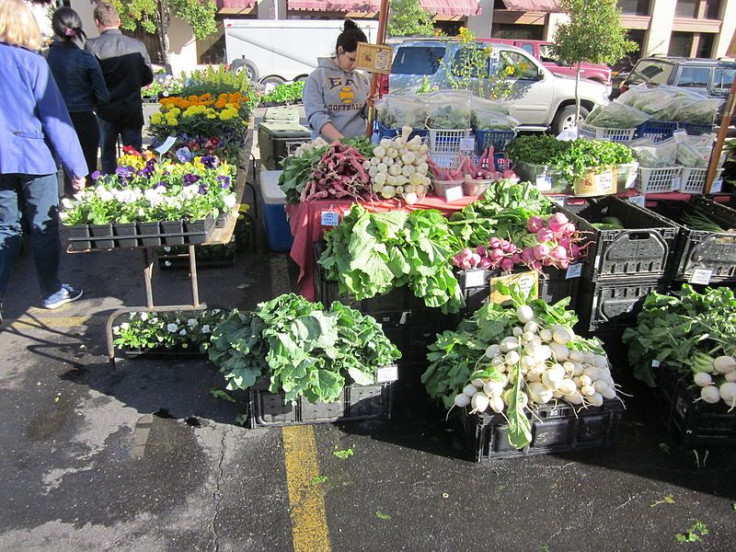Farmers Market Benefits: How Buying Healthy Produce Helps You And Your Community

The arrival of summer is just a day away, and with farmers markets already springing throughout the country, there's no time like the present to reap the benefits of healthy produce in your community. Farmers markets are mostly open during the peak harvest season, which is often the prime summer months. While the average seasonal farmers markets are open for approximately four and a half months in a year — late spring through early fall — 15 percent of all farmers markets were open during the winter months in 2010, reports the Farmers Market Coalition (FMC). According to the United States Department of Agriculture (USDA), there were approximately 7,900 farmers markets in the country in 2012 — an increase of 9.6 percent since 2011. The increase in these figures represents greater consumer interest in buying fresh and healthy products directly from the farm, cutting out the "middleman." The farmer and consumer relationship provides a secure and regular market outlet where farmers avoid the burden of producing the quantity required by many U.S. supermarkets.
Alison Bailey, M.D., Harvard trained integrative medicine specialist, said to Medical Daily, "Fruits and vegetables that are grown locally and eaten soon after harvesting retain more of their nutrients than those that are shipped from further locations and sit on supermarket shelves for long periods of time."
"Also, eating food that are "in season", such as those grown locally and purchased at a Farmer's Market, or better yet, a community supported agricultural program, are often grown organically..." she said. Consumption of locally grown fresh and healthy produce means cost effective options, more nutrients and vitamins, and an ecofriendly environment.
Consumer Benefits of Farmers Market
Purchasing products at a farmers market allows the consumer to get the most out of their food shopping experience. "It's a great way to purchase nutrient-rich foods at lower costs, get familiar with less familiar produce, and discover where their foods come from," said Kati Mora, MS, RD Owner and Director of Nutrition Communications, to Medical Daily. There is direct contact between the consumer and the producer where both parties can provide feedback to one another on the origin and growth process of the products. Access to farmers markets and thus fresh food can help improve a person's diet and nutrition. Recently in New York, Governor Cuomo announced that $3.4 million would go to low-income women,infants, and children to increase their access to healthy, locally-grown food at farmers' markets. Over 250,000 families will have access to healthy food at 470 farmers' markets as a means to promote healthy eating for those that may not otherwise be able to afford the cost of locally grown food.
Perk: Going to a farmers market can be a great way to learn some secret recipes on how to cook and prepare fresh ingredients from the producers themselves.
Community and Local Economy Benefits of Farmers Market
The presence of a farmers market in the community means the opportunity to interact with members of the community. Mora told Medical Daily, "It is also great for the community because money spent at a Farmer's Market stays in the community, people get the opportunity to meet and converse with others who live near them, and discover new vendors and businesses that can help support their healthy lifestyles." The local economic benefits of a farmers market in a community is inevitable. The money that is spent in the local community is circulated within it, which has long term effects such as preserving and creating local jobs. In 2008, fruit and vegetable farms that had local and regional markets employed 13 full-time workers per $1 million earned in revenue, which created a total of 61,000 jobs, according to a 2011 USDA Economic Research Report.
Ecofriendly Benefits of Farmers Market
While healthy produce is an incentive to visit a local farmers market, the environment benefits also weigh in. The "food miles" — the distance food travels from where it is grown to where it purchased or consumer — is significantly reduced when it comes to farmers markets. Food in the U.S. travels an average of 1,500 miles to get to your kitchen table, which uses a large amount of natural resources such as fossil fuels, says the Center for Urban Education about Sustainable Agriculture. Carbon dioxide emissions and packing materials are reduced as the rise of these markets promote a more environmental approach when it comes to food production. A healthier environment translates into a healthier food consumer as the demand for pesticide-free and organic products continues to grow. "Many pesticides have estrogen like actions in the body (xenoestrogens) and may be linked to breast and uterine cancer as well as other chronic pain and health issues. This has been demonstrated in animal models," Bailey told Medical Daily.



























